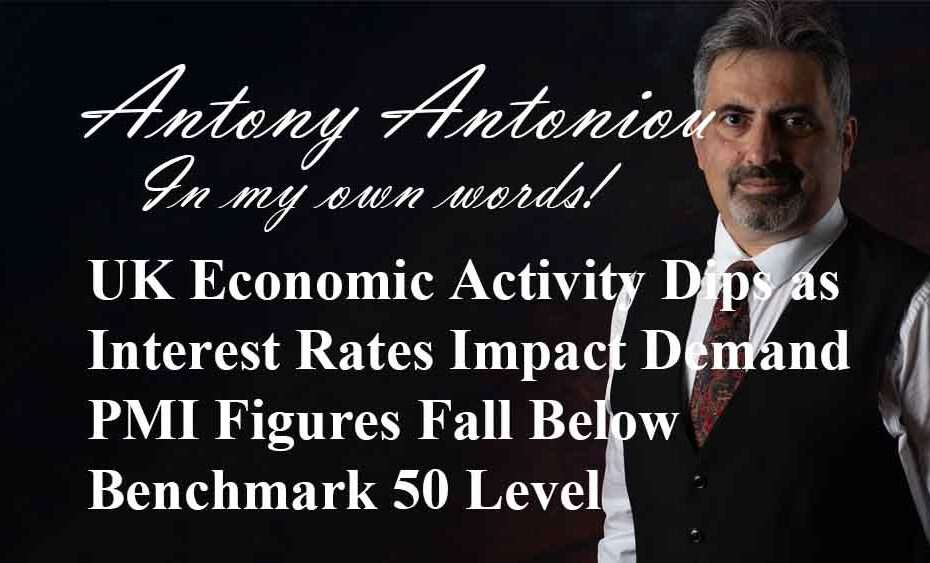UK Economic Activity Dips as Interest Rates Impact Demand – PMI Figures Fall Below Benchmark 50 Level
**Introduction**
The UK’s economic landscape took an unexpected turn in August, experiencing its first decline since the beginning of the year. This setback comes as higher interest rates begin to take a toll on demand, as indicated by a closely observed survey. The flash UK composite purchasing managers’ index (PMI), a reliable gauge of economic health, dropped to 47.9 in August, down from July’s 50.8 and slipping below the critical 50 threshold for the first time since January. This decline has raised concerns about the nation’s economic trajectory, as experts analyze the implications of this shift.
**A Sign of Economic Contraction**
A reading below 50 on the PMI indicates that a majority of businesses are reporting contraction. August’s figure, significantly below the 50.3 forecast by economists in a Reuters poll, hints at a potential economic contraction. Chris Williamson, chief business economist at S&P Global Market Intelligence, which releases the survey, pointed out that a pronounced manufacturing downturn, coupled with the service sector’s waning revival, makes an economic contraction seem inevitable. He projected that the survey results might translate to a 0.2% GDP decline in the third quarter.
**Interest Rate Impact**
The impact of higher interest rates is highlighted as a driving force behind the economic decline. The Bank of England (BoE) has been on a streak of raising interest rates, marking the 15th consecutive increase since December 2021. With the benchmark rate now standing at 5.25%, a 15-year high, economists like Paul Dales from Capital Economics see the data as an affirmation that these higher rates are indeed having an effect. The anticipation of an impending GDP contraction leading to a “mild recession” is gaining ground.
**Mixed Expert Opinions**
While the figures may not be enough to dissuade the Bank of England from further rate hikes, experts are divided on the future course. Martin Beck, chief economic adviser to the EY ITEM Club, believes that the current data may not prevent future rate increases, but they might indicate that the next one, if it occurs, could be the final move in the current cycle. This uncertainty is a reflection of the delicate balance that the Bank of England must strike to manage both inflation and economic growth.
**Sectoral Challenges**
The challenges faced by different sectors contribute to the overall economic decline. The services sector, for instance, contracted for the first time since January, with the lowest output reading in 31 months. Simultaneously, the manufacturing sector experienced its sixth consecutive month of falling output. These setbacks are attributed to a mix of factors, including the cost of living crisis, export losses, higher borrowing costs, and general economic uncertainty.
**Impact on Demand and Prices**
The survey pointed to a fall in orders for goods and services, driven by weakened demand amid various economic concerns. While input costs showed slower growth, private sector companies increased their average prices at the slowest rate since February 2021. The impacts of higher interest rates are beginning to reflect in these trends, influencing both demand and the pricing dynamics across sectors.
**Aiming for a Balanced Approach**
The Chief Economist of CIPS, John Glen, noted that higher interest rates are slowly having the intended impact of curbing demand and reducing inflationary pressures. This has led to moderated input costs and lower raw material prices for manufacturers. Striking the right balance between containing inflation and maintaining economic growth remains a key challenge for policymakers.
**Conclusion**
The unexpected decline in the UK’s economic activity in August underscores the impact of higher interest rates on demand. As the flash UK composite PMI fell below the benchmark 50 level for the first time since January, experts are closely watching for signs of economic contraction. The ongoing dance between raising interest rates to control inflation and ensuring economic growth remains a challenge for the Bank of England. As the economic landscape continues to shift, finding this equilibrium will be crucial for the country’s economic future.

